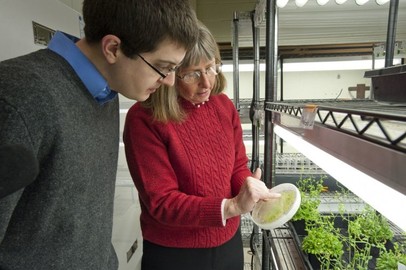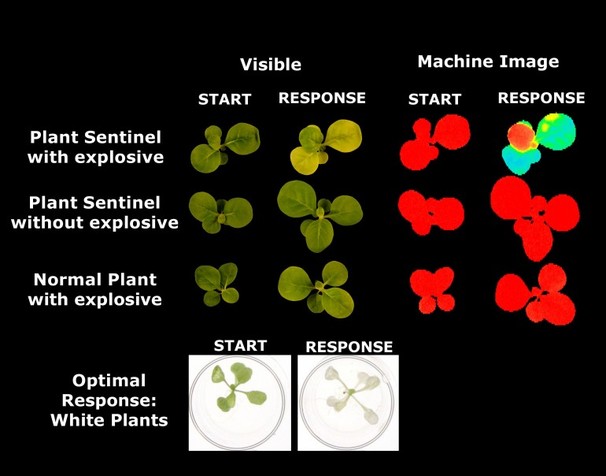 (Dr. June Medford, with some of her pollutant- and explosive-sniffing plants) (Gizmag) There may come a day when certain plants in your workplace suddenly turn white, at which point everyone will run screaming from the building – those co-workers will have been right to do so, as the white plants indicated that a toxic gas was present. Before that scenario can take place, a little more work still needs to be done, and Colorado State University (CSU) biologist Dr. June Medford is doing it. Using a computer-designed detection trait, she is creating plants that stop producing chlorophyll when they detect pollutants or explosives in the air. According to Medford, plants such as tobacco are as good as or better than a dog’s nose for detecting airborne substances. Unlike dogs, however, plants don’t need to be trained, housed or fed. They also don’t need to be powered or protected from the elements, unlike electronics. With help from colleagues at Duke University and the University of Washington, Medford redesigned naturally-occurring receptor proteins using a computer program. She then modified the receptors to function in plants, and targeted them to the test plants’ cell walls. In the first generation of plants, the receptors were able to detect pollutants and explosives in the air or soil near each plant, and caused chlorophyll suppression within a matter of hours. In future generations of plants, Medford and her CSU team would like to get that reaction time down to a matter of minutes. They are also interested in causing the plants to change color in ways not visible under normal conditions, so that authorities using the right equipment (such as infrared lights) could detect the activity of people such as bomb-makers, before those people knew that they had been detected.
Once the pollutant or explosive itself has been removed, the plants return to their usual green coloration. The sniffer plants could conceivably be “deployed” in high-terrorist-risk locations such as airports, malls or arenas, or around places like schools or people’s homes. If enough of the plants were situated in an outdoor location, satellites would even be able to detect their color changes. Any type of plant could be used, and could be capable of detecting multiple pollutants at once. Apparently none of that can happen, however, until many more years of research have been completed. Even then, widely distributing such genetically-modified plants will present legislative and environmental challenges of its own. The research is being funded by the Department of Homeland Security, the Defense Advanced Research Projects Agency (DARPA), the Office of Naval Research (ONR), and other groups. All images courtesy Colorado State University. Original Article:http://www.gizmag.com/color-changing-plants-detect-pollutants-and-explosives/17915/
0 Comments
Your comment will be posted after it is approved.
Leave a Reply. |
News Watch
Mind-opening news articles, editorials, videos & apparel that inspire our readers and help liberate them from the status quo. Stay informed.
Write For UsSpace WatchTop NewsNews Watch Categories
All
|
|
|
HAVE A TIP OR STORY TO TELL? JOIN TODAY & SHARE YOUR STORY!
If you have a breaking news tip or idea, please email: [email protected] Apparently Apparel® is a registered trade name and part of the ZOAT International® brands network. © 2007-2023. All Rights Reserved. Privacy Policy. All art & news content posted on this site is commentary or opinion and is protected under Free Speech. ApparentlyApparel.com is not responsible for content written by contributing artists, authors or news feeds. The information on this site is provided for educational and entertainment purposes only. It is not intended as a substitute for professional advice of any kind. ApparentlyApparel.com assumes no responsibility for the use or misuse of this material.
|
|







